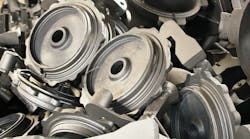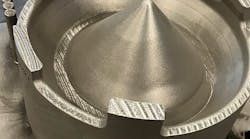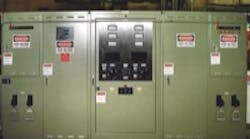Acheson is a job shop producing prototype castings, and performs some specialized work in cast-iron restorations for military and railroad equipment. Its Inductotherm Dura-Line furnaces — one 1,000-lb vessel installed with the original power supply in 1980, and a 1,500-lb furnace added a few years later — were still working fine, and while the contractor had done a good job keeping the old power supply running, many of replacement parts were no longer available.
In 2004, Acheson Foundry replaced its induction-power supply system an Inductotherm 600-kW Dual-Trak® unit, with built-in Melt-Manager® computerized controls. "This new unit was set up with a limit of 400 kW so we would not exceed our electric demand," Rigsby notes. "It was all the power we needed, but the full 600 kW remained available to power future growth." The foundry also installed a new Inductotherm closed-loop evaporative water cooling system to replace its original open water cooling system.
The system replacement proceeded quickly. "We needed to build a metal stand for the Dual-Trak unit and modify the bus trench," Rigsby says. "Much of the work, however, could be done while we continued production with our old unit. There were only 10 days of downtime needed to complete the installation." He points out, "We did not have to do anything to our existing furnaces to use them with the Dual-Trak unit."
Being able to use its existing furnaces with a new power supply was an advantage for Acheson, producing significant cost savings for capital-equipment purchases and installation, Rigsby says. Also, Acheson was able to use its existing incoming-power transformers, resulting in additional savings.
Regarding the new cooling system, Rigby notes, "The closed cooling system solved our water issues. The old, open system required a lot of maintenance, and when it was removed we could see how build-up over the years had clogged many of the pipes. The new system with water and glycol is much cleaner and runs much cooler. It does not require nearly as much maintenance," he said.
Unlike the former, single-output power unit, the new dual-output power supply is able to send power to both of Acheson's furnaces at the same time for melting and holding. "We melt a complete charge in one furnace while we pour from the other." Rigsby explains. "About 90% of the power goes to the melting furnace, while 10% is used to maintain the temperature in the pouring furnace. With our single-output power system, we were losing 20 minutes of melting time while were pouring. Now, with the Dual-Trak system we keep the melt ‘rocking and rolling' while we are pouring. So when the pouring furnace is empty, the melting furnace is ready to pour," he says.
Rigsby says that dual-output melting operations make it possible for Acheson to pour 3,000 lb more metal per day than was possible with its old, single-output system, at the same 400-kW demand level. "Our average daily production is 7,500 lbs," he says. This means that the additional metal represents 66% more daily production, without increased demand charges.
"In the past, the molders waited for metal." Rigsby says. "Now, it's the melters waiting for the molders to catch up."
"There is not much a small foundry can do about increasing power rates," he continues. "In our area, power rates were relatively flat until last year when they went up 7.5%. This year they are going up another 10%. Increasing production while keeping a cap on demand is one of the few ways a foundry can help to control its power cost per ton of metal melted," he said.
"At Acheson we melt gray and ductile iron, Ni-hard, and some steels. Induction batch melting gives us great metal flexibility," Rigsby said.
Also, the dual-output power supply has allowed Acheson Foundry to increase the size of the castings it produces. "Now we can melt and hold the metal in one furnace at pouring temperature while we melt in the second furnace," Rigsby explained, allowing Acheson to pour molds as large as 2,500 lb. "This has proven to be very useful for us and has brought us a lot of new business," he said.
The built-in computerized operator assistance system has been productive for Acheson. "With the Melt-Manager system on our Dual-Trak unit, the learning curve for the operator was not bad," Rigsby said "Melt-Manager really is user-friendly. We use it to preheat the furnaces in the morning. We especially like the sintering feature and the alarm history. The Melt-Manager's control of sintering gives a much better sinter, and the lining lasts longer than it did when we ran the sinter ourselves," he said.
Updating its melt shop was first step in Acheson's capital improvement program, the goal of which is to upgrade the equipment to meet Acheson's increasing production demands. "Melting is the heart of the foundry. If you don't have melting, you don't have anything," Rigsby observed. "With the way our business is growing, we soon will need to remove the 400-kW power limit and use the new unit's full 600-kW capacity."
William Kelly is a district manager with Inductotherm Corp. Read the full presentation, "More Power, Better Results for Induction Melter."










